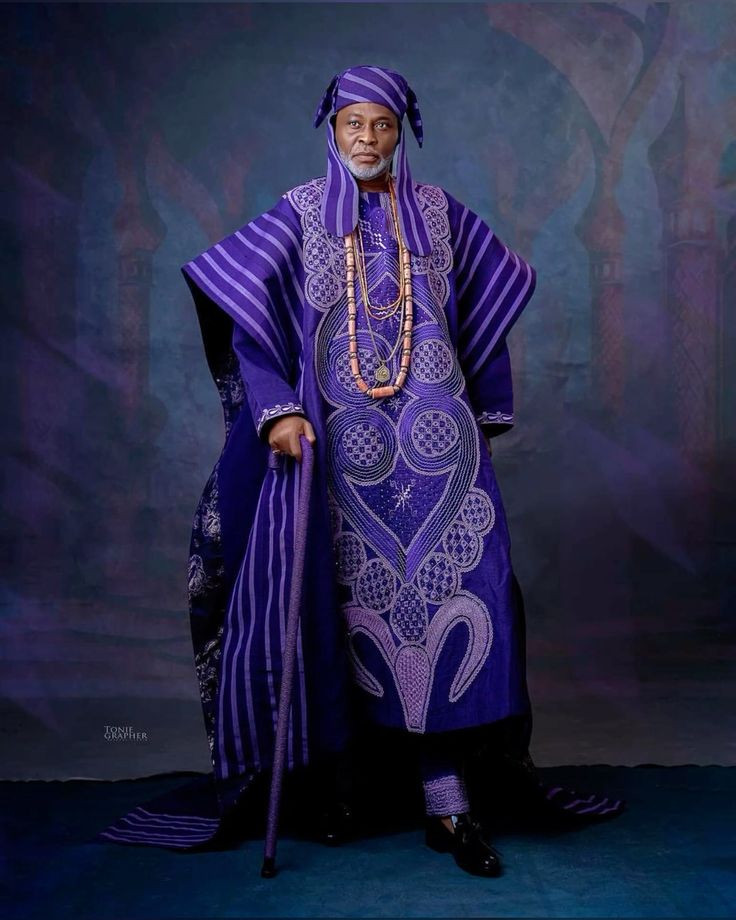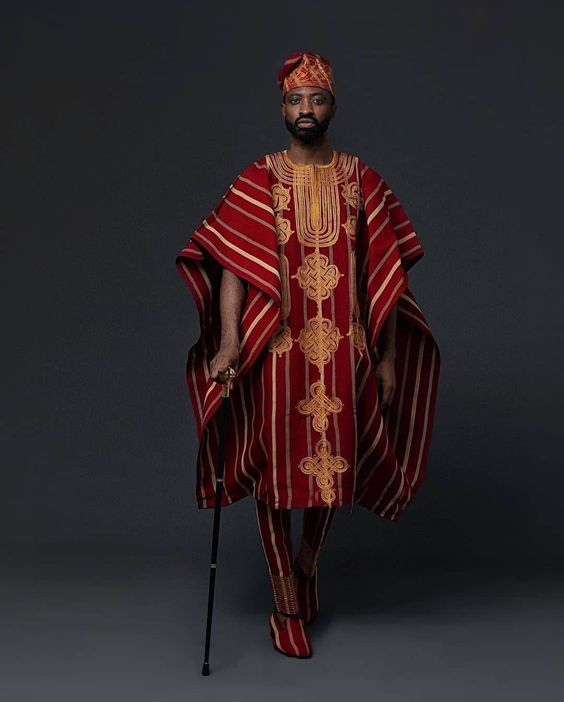Aso Oke for Men: From Traditional to Trendy in 5 Steps

Introduction
Aso Oke for Men, a traditional Nigerian fabric, is a vibrant symbol of cultural heritage for the Yoruba people. This handwoven textile, known for its intricate patterns and bold colors, has been an essential part of ceremonial attire like weddings and festivals for a long time.
The importance of Aso Oke in Yoruba tradition is immense. It signifies more than just fashion; it embodies identity, pride, and a strong connection to ancestral roots.
Recently, Aso Oke for men has made a comeback in contemporary fashion. Designers are giving this classic textile a fresh look by combining it with modern styles to create fashionable yet culturally meaningful pieces. This guide aims to help men embrace Aso Oke, offering practical tips and insights on incorporating this unique fabric into your wardrobe.
Step 1: Understanding Aso Oke and Its Cultural Significance
Aso Oke is more than just a textile; it embodies the essence of cultural heritage for the Yoruba people. Handwoven with meticulous care, this fabric serves as a symbol of identity and pride. The term “Aso Oke” translates to “top cloth,” indicating its esteemed status among traditional Yoruba attire.
Symbol of Cultural Heritage
For the Yoruba community, Aso Oke signifies deep-rooted traditions passed down through generations. Each piece carries intricate patterns and vibrant colors that narrate stories of ancestry and communal values. The artistry involved in creating Aso Oke reflects the skill and dedication of artisans, highlighting its cultural importance. This connection to Yoruba culture and tradition is vital in understanding the fabric’s significance.
Historical Significance in Ceremonial Contexts
Aso Oke’s historical significance is particularly pronounced during ceremonies such as weddings, festivals, and other celebratory events. Traditionally, it is worn by both men and women to mark special occasions:
- Weddings: A groom dressed in a striking Aso Oke outfit exudes elegance and respect for his cultural roots. This ceremonial attire often includes matching caps (Fila) and accessories.
- Festivals: During major Yoruba festivals like Egungun or Osun-Osogbo, participants don Aso Oke to honor their deities and ancestral spirits, enhancing the spiritual ambiance with their vibrant attire.
The use of Aso Oke in these contexts underscores its role not only as clothing but as an integral part of Yoruba rituals and celebrations.
Embracing Tradition Through Fashion
Understanding the cultural significance of Aso Oke can deepen your appreciation for this remarkable fabric. It represents a connection to heritage, making it a powerful choice for those looking to express their identity through fashion.
By recognizing the importance of Aso Oke in Yoruba culture, you can embrace both its traditional and contemporary applications with respect and authenticity.
Step 2: Embracing Traditional Styles of Aso Oke for Men
Agbada

Agbada is one of the most iconic traditional outfits for men in Yoruba culture. This grand, flowing robe is often made from Aso Oke fabric, characterized by its intricate patterns and vibrant colors.
Features:
- Three-piece ensemble: Includes an inner shirt (Buba), a pair of trousers (Sokoto), and the large flowing outer robe (Agbada).
- Intricate embroidery: Often adorned with elaborate embroidery that accentuates its regal appearance.
- Occasions: Typically worn during significant events such as weddings, religious ceremonies, and cultural festivals.
Dansiki

Dansiki offers a more casual yet equally traditional option compared to Agbada. This short tunic is versatile and comfortable, making it ideal for various settings.
Features:
- Loose-fitting design: Enhances comfort while allowing ease of movement.
- Shorter length: Falls around the waist or hips, making it less formal than Agbada.
- Occasions: Suitable for semi-formal events and everyday wear, including family gatherings and casual outings.
Fila

No traditional Yoruba attire is complete without the Fila, a distinctive cap that adds the finishing touch to both Agbada and Dansiki outfits.
Significance:
- Symbol of respect: Wearing a Fila signifies respect and adherence to cultural norms.
- Variety of styles: Available in different shapes and designs, such as Gobi (a soft cap) and Abeti Aja (a cap with flaps resembling dog ears).
- Complements the outfit: Enhances the overall aesthetic by matching or contrasting with the colors and patterns of Aso Oke garments.
Combining these elements creates a cohesive look that honors tradition while allowing personal expression through style choices.
Step 3: The Evolution of Aso Oke in Modern Fashion
Contemporary designers are redefining the use of Aso Oke to appeal to today’s fashion-conscious audience while respecting its rich cultural heritage. This shift has opened new avenues for men to incorporate this traditional fabric into their wardrobes.
Reinterpretation by Modern Designers
Modern designers are weaving Aso Oke into contemporary menswear, making it more accessible and versatile. They focus on:
- Tailored Fits: Traditional loose-fitting garments are being replaced with tailored silhouettes that offer a modern twist.
- Color Variations: While traditional Aso Oke is known for its vibrant colors, contemporary versions include more subdued tones to suit different tastes.
- Mixed Fabrics: Combining Aso Oke with other fabrics such as cotton or silk creates unique textures and styles.
- Fashion Technology Integration: The incorporation of fashion technology trends is also revolutionizing the way Aso Oke is designed and produced, enhancing efficiency and creativity in the process.
Kenneth Ize’s Innovative Approach
Kenneth Ize stands out as a prominent figure in this modern reinterpretation. His menswear collections showcase how Aso Oke can blend tradition with contemporary aesthetics. Key elements of his work include:
- Innovative Designs: Kenneth Ize’s collections often feature gender-neutral silhouettes and tailored suits, integrating Aso Oke in ways that honor its origins while appealing to modern sensibilities.
“My aim is to merge the old with the new, creating pieces that tell a story of cultural continuity,” says Kenneth Ize.
- Global Influence: By presenting his work on international runways, Ize brings global attention to Aso Oke, highlighting its versatility beyond African borders.
- Sustainable Practices: Emphasizing sustainability, Ize works with local artisans to ensure that traditional weaving techniques are preserved, supporting both cultural heritage and eco-friendly fashion.
This evolution signifies a broader acceptance and appreciation of Aso Oke in various fashion circles. The fabric’s adaptability ensures it remains a significant element of contemporary menswear trends, allowing men to express their individuality while honoring their heritage. As we look towards the future, it’s clear that the influence of Aso Oke will continue to grow, with its potential being further explored in line with 2024 fashion trends.
Step 4: Styling Tips for Wearing Aso Oke Today
Incorporating Aso Oke into your wardrobe offers a unique way to showcase cultural heritage while staying fashion-forward. Here are some practical suggestions on how to style Aso Oke outfits for different occasions:
Formal Events
For formal occasions, such as weddings or cultural ceremonies, Aso Oke can be worn in its traditional form to make a grand statement:
- Agbada Ensemble: Pair an intricately woven Agbada with matching trousers and a Fila cap. The voluminous robe and rich fabric patterns exude regality.
- Danshiki Combo: A Danshiki, paired with tailored pants, offers a more streamlined yet traditional look. Accessorize with bold jewelry to elevate the outfit.
Casual Outings
You can infuse casual outings with cultural flair by blending traditional fabrics with modern silhouettes:
- Aso Oke Jacket: Layer an Aso Oke jacket over a plain t-shirt and jeans. This combination balances the vibrancy of the fabric with everyday essentials.
- Aso Oke Shirt: Opt for an Aso Oke shirt paired with chinos or shorts. This creates a relaxed yet stylish ensemble, perfect for weekend gatherings.
Balancing Traditional Fabrics with Modern Pieces
To achieve a versatile look that reflects personal style without compromising cultural integrity:
- Mix Textures: Combine Aso Oke pieces with other fabrics like denim or cotton. For instance, an Aso Oke blazer over a crisp white shirt and denim jeans offers a chic contrast.
- Accessorize Thoughtfully: Use accessories to bridge traditional and modern styles. Leather belts, contemporary shoes, and minimalist jewelry can complement the rich patterns of Aso Oke.
Fashion Versatility
The beauty of Aso Oke lies in its versatility:
- Layering Techniques: Layering different pieces allows you to adapt your outfit to various settings. An Aso Oke scarf or shawl adds texture and color without overwhelming the look.
- Color Coordination: Pay attention to color coordination when mixing Aso Oke with other wardrobe staples. Neutral tones often highlight the vibrant hues of traditional fabrics.
Exploring these styling tips will enable you to incorporate Aso Oke seamlessly into both formal and casual attire, showcasing its fashion versatility while honoring its rich cultural heritage.
Step 5: Why Every Man Should Consider Adding Aso Oke to His Wardrobe
Adding Aso Oke to your wardrobe has many advantages beyond its beautiful appearance. This traditional fabric is a great way to express your culture, letting you show off your heritage and pride through what you wear. Each piece of Aso Oke has its own story, carrying historical importance and cultural identity into your everyday outfits.
Reasons to Wear Aso Oke
- Cultural Pride: Wearing Aso Oke fosters a sense of cultural pride. This textile is deeply rooted in Yoruba tradition, and by integrating it into your attire, you celebrate and preserve these customs. The importance of wearing traditional clothes extends beyond mere aesthetics; it’s about embracing and valuing one’s heritage.
- Fashion Identity: Aso Oke provides a unique fashion identity that sets you apart. Its intricate patterns and vibrant colors make a bold statement, distinguishing your style from mainstream fashion.
- Uniqueness: Each Aso Oke garment is handwoven and unique, ensuring that no two pieces are exactly the same. This exclusivity adds a personal touch to your wardrobe, enhancing your individuality.
By embracing both traditional and modern styles of Aso Oke, you support the continuation of cultural traditions while also making a unique fashion choice.
Conclusion
Adding Aso Oke to your wardrobe is more than just a fashion choice; it’s a blend of tradition and modern style. This special fabric lets you honor your roots while expressing your unique fashion sense. Whether you choose classic designs or trendy versions, Aso Oke can deeply influence how you express your culture.
For men, Aso Oke is a chance to proudly display their heritage, combining the past with the present. Explore this vibrant textile world and make every outfit a statement of your identity.